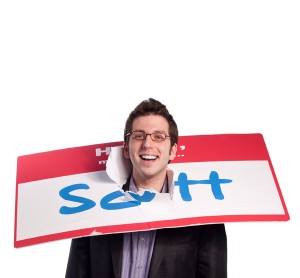You’ve chosen an uncertain path.
You’ve adopted an inconvenient lifestyle.
You’ve embarked upon an unconventional journey.
You’ve felt the voice inside you growing more urgent.
You’ve committed yourself enough so you can’t turn back.
IN SHORT: You’ve decided to play for keeps.
This is the critical crossroads – the emotional turning point – in the life of every young artist.
I’ve been there myself, and here’s a list of suggestions to help you along the way: (Read part one here, part two here, part three here, part four here, part five here and part six here.
1. Bring yourself into risk territory. In the book Wisdom, Robert Redford cautions, “Once you begin thinking about security, you begin to erode yourself as an artist and stop being able to take the risks you need to take.”
That’s the challenge: You have to be willing to step across the lines of safety and to accept the surprises of the outcome. Otherwise your work remains stale and uninspired. Nothing but a series of boring reproductions doomed to disappoint.
Personally, I find that it’s helpful to create a filter. A ritual that audits the level of risk in your creative endeavors. Two questions you might ask are: “What do I risk in releasing this work?” and “Who will this piss off?”
By doing so, you bring risk to the frontline of your artistic awareness. And the work you execute speaks with a daring voice that’s impossible to ignore. Your challenge is to customize your own practice. Whatever it takes to sustain your status as an agent of chaos.
Remember: Art without risk, isn’t. Do you dare your genius to walk the unknown path?
2. Ask for the sale. Artists aren’t typically the best salespeople. Most experience physical pain when they’re forced to assign monetary value to their intellectual and creative property.
But, as Jason Friend wrote in a recent article, “Never be afraid to put a price on something. If you pour your heart into something and make it great, sell it – for real money. Even if there are free options, even if the market is flooded with free, people will pay for things they love.”
The cool part is, charging for something makes you want to make it better, says Fried. Which means your product is going to improve by virtue of people paying for it. Which means over time, they’re going to pay more for it.
Here’s my suggestion: Never apologize for your pricing.
You deserve to be compensated commensurate with your value. State your feel confidently and shut up. Because he who speaks next, loses. You just have to believe that people love to pay for what they love – your work. Are you asking them to open their wallets?
3. Commitment trumps discipline. Here’s the biggest misconception about me: I’m not really that disciplined – I’m just obsessively focused on what’s really important. Turns out, when you actively cultivate the purpose driven nature of your work, discipline becomes a non-thought.
That’s how commitment works: It deletes distraction. It makes you wake up early. It turns habits into non-negotiables. And when you’re committed, you drop everything and get to work. Every day.
That’s the reality about being an artist: The work is always an outgrowth of who you are. Your deepest values. Your personal constitution. And if there isn’t a shade of significance in the work, it will never get done.
Remember: Discipline derives from the wellspring of why. If you truly want to play for keeps, you have to play every day. And the game has to be meaningful to you. Otherwise, you lose. What will your commitments enable you to do?
4. It’s not about doing more – it’s about doing different. If you’re stuck seeing your life from the same angle, not only will your art suffer – your soul will suffer too. And until you explore the possibility of living differently in some way, both will continue to do so.
The bad news is: I don’t have a collection simplistic tactics for temporarily boosting creativity like taking different route to work or wearing mismatched socks.
What I’m suggesting is dramatic personal displacement. Bringing yourself to a place that’s so uncomfortable, you have no choice but to be creative in every area of your life.
After all: You didn’t come here to do what has already been done. It’s time to accept the risks of committing to a new path and take your chance in the struggle. In the book Life Change Artists, Fred Mandell sums it up well:
“We overestimate the magnitude of risk we take in changing our lives, and underestimate our personal ability to successfully navigate such a change.”
Look: There’s always another door to open, and there’s always an adventure attached to it. You just have to jump. And you have to believe that you’ll be fine. When was the last time you stepped back from the canvas of your life and flipped your routine on its ass?
5. Finishing is for beginners. Real art never finishes. And even though your head will make sure your heart never gets that memo, you’ve got to press on anyway. Even if nobody notices the work you’re putting out. I learned this lesson from Robert Henri, who said:
“All any man can hope to do is to add his fragment to the whole. No man can be final, but he can record his progress.”
That’s the secret to longevity in the art world: Hunkering down with your work – every single day – and accepting that not everything you make will feel like a masterpiece. Instead, get good at starting. Stay focused on contributing to your ongoing body of work, not just a single song.
After all: Good artists are masters of promiscuity – not perfection. Their legacy is the result of volume – not accuracy. And if you can wake to the canvas of a fresh day with such purity of intent, you will win. Are you closing the book or showing the world that there are still more pages possible?
6. The greatest gift you can give is your experience. Art is the fundamental expression of who you are. It’s the autobiography of your deepest thoughts and unique collection of universal human emotions you bring to the table. As Tolstoy advised, “Write only with your pen dipped in your own blood.”
For that reason, my definition of art making has always been: “Slice open a vein and bleed your truth all over the page.” That’s where your best work is born. The good news is: It has less to do with skill and talent and more do with will and honesty.
The bad new is: It’s a risk, it hurts and it’s going to take all of you. But it’s absolutely worth it. If you want to play for keeps, go there. Commit to self-disclosure. Ask penetrating questions with your work. And make some risky art.
Remember: The more personal and intimate you are willing to be, the more universal your work become. Where are you willing to take people with you work?
REMEMBER: When you’re ready to play for keeps, your work will never be the same.
Make the decision today.
Show the world that your art isn’t just another expensive hobby.
LET ME ASK YA THIS…
Have you committed with both feet yet?
LET ME SUGGEST THIS…
For the list called, “14 Things You Don’t Have to Do Anymore,” send an email to me, and you win the list for free!
* * * *
Scott Ginsberg
That Guy with the Nametag
Author, Speaker, Entrepreneur, Mentor
[email protected]
Now booking for 2011-2012!
Watch The Nametag Guy in action here!

